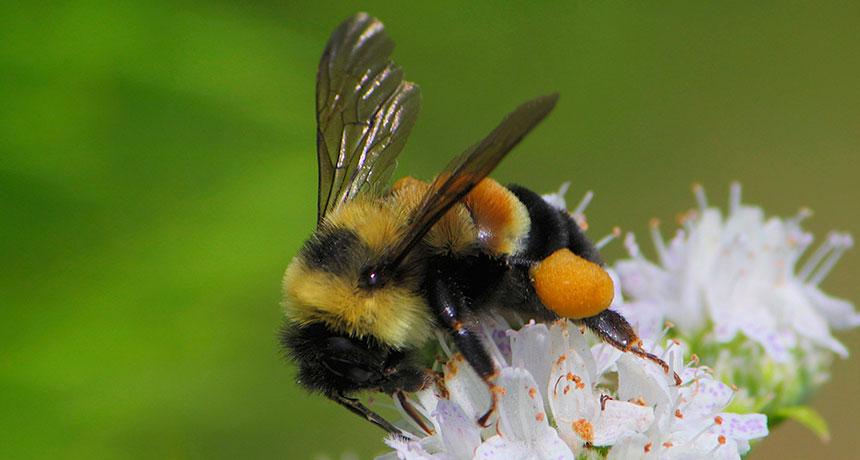Climate change shrinks bumblebee’s range
As the planet heats up, these insects now inhabit only the cooler parts of their range

Rising temperatures are shrinking the home ranges of bumblebees, such as this rusty-patched species (Bombus affinis).
DAN MULLEN/FLICKR(CC BY-NC-ND 2.0)
By Beth Mole
As climate change marches on, bumblebees are losing ground.
With rising temperatures, bumblebees are disappearing from the southern parts of their ranges, a new study finds. Yet at their northern borders, many species are holding steady instead of moving into even cooler areas. This means that the bees’ overall range — the area in which these species live — is shrinking.
It’s the first time scientists have shown clearly that climate change is shrinking bumblebee habitat. Bumblebees are important pollinators of plants, including crops. The bee populations had already been in trouble due to pesticides and diseases. But the new study offer new hints on why the bees could continue to die out. They might even disappear from some areas.
“This is something that is not a problem for the future,” says study coauthor Jeremy Kerr. “It’s happening right now and has actually now been going on for decades.” Kerr is an ecologist at the University of Ottawa in Canada.
Kerr and his colleagues studied insect collections from museums and other places. Their data come from more than 423,000 bumblebees. All were caught between 1901 and 2010 in North America and Europe. They included 67 species, which is about half of the bumble species that live in those regions.
The records also had noted where the bumblebees had been caught. This let the researchers map any changes over that time in where the insects were living.
From 1974 to 2010, the bumblebees’ home turf in North America and Europe has heated up. The average high temperatures in these areas jumped 2.5° Celsius (4.4° Fahrenheit). During those same years, some of the bumblebees’ southern borders moved north by around 300 kilometers (186 miles).
That’s huge, says Kerr. For example, the rusty-patched bumblebee, Bombus affinis, was once common in gardens in the southern United States. Today, it has nearly vanished from there. In contrast, some other insect species, such as butterflies, aren’t losing any ground.
Bumblebees are very sensitive to heat, Kerr explains. They now seem to be disappearing from the hotter parts of their former ranges. Bumblebees that live in the mountains also have moved. They’ve shifted their ranges about 300 meters (almost 1,000 feet) upward, to cooler elevations.
Yet, along the northern edges of their habitat, most bumblebees are staying put. Kerr says this is “really weird.” That contrasts with many other species, he says, which are moving their ranges northward in response to climate warming.
The scientists reported their results July 10 in Science.
“The results are both intriguing and concerning,” says Scott Hayward. A biologist at the University of Birmingham in England, Hayward wasn’t involved in the study. He says that to understand why many bumblebees aren’t budging north, researchers will need to focus on bumblebee biology, which in some ways is still a mystery.
Power Words
(for more about Power Words, click here)
climate change Long-term, significant change in the climate of Earth. It can happen naturally or in response to human activities, including the burning of fossil fuels and clearing of forests.
ecology A branch of biology that deals with the relations of organisms to one another and to their physical surroundings. A scientist who works in this field is called an ecologist.
elevation The height or altitude at which something exists.
habitat The area or natural environment in which an animal or plant normally lives, such as a desert, coral reef or freshwater lake. A habitat can be home to thousands of different species.
pesticide A chemical or mix of compounds used to kill insects, rodents or other organisms harmful to cultivated plants, pet or livestock, or unwanted organisms that infest homes, offices, farm buildings and other protected structures.
pollinator Something that carries pollen, a plant’s male reproductive cells, to the female parts of a flower, allowing fertilization. Many pollinators are insects such as bees.
range The full extent or distribution of something. For instance, a plant or animal’s range is the area over which it naturally exists. (in math or for measurements) The extent to which variation in values is possible. Also, the distance within which something can be reached or perceived.







